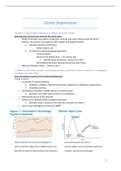Digital Organisation
Chapter 1: Information Systems in Global Business Today
Opening case: Smart stores reinvent the retail space
o AWM Frictionless uses object-recognition cameras and smart shelves (with proximity
sensors, 3D cameras, microphones, RFD readers and weight sensors)
• Improve operational efficiency
- Collect data to use
• Create personalized shopping experience
- Locate products
- Check out by exiting store -> no need to pay
▪ Identify buyer by camera, receipt via e-mail
- Personalized discounts because they know who it buys
o Walmart, ABInbev, Pepsi, … want to use it
1.1 How are information systems transforming business, and why are they so essential for running and
managing a business today?
How Information Systems Are Transforming Business
Trends in the IT:
o Increasing IT-related spending
• Hardware, software, telecommunications equipment is bought by organisations
• Consulting services
o Smartphones and other mobile devices to communicate
• Example: now check bank account on smartphone
o Widespread access to the internet
o Online social networks (have changed businesses)
• Example: leave a review on the internet, business can read it
o Laws concerning digital records (e.g. GDPR)
Total investment can also be in buildings etc. Use to know where to invest in
Total investment suffered from 2008 financial crisis Gartner publish some interesting investments
Now 33% of total inv., good decisions are important 5 phases, life cycle of technologies
1
,Example Gartner hype cycle
Nonfungible token = smart contract based on blockchain technology and gives you ownership of
digital product (example: Chloe meme)
Every technology has other colour -> stands for when they expect it will reach its peak
Not interesting for small businesses
Smaller businesses, simpler
Digital workplaces will never stop, not even after
covid
2
, o What’s New in Management Information Systems
• IT Innovations: the way in what IT is managed
- Cloud computing, big data, Internet of Things
- AI and machine learning
• New Business Models
- Online streaming music and video
• E-commerce Expansion
- Selling physical products (e.g. Zalando)
- Selling services (e.g. Netflix, Spotify, Coursera)
- Selling both (e.g. Amazon)
• Management Changes
- Managers use social networks, online collaboration tools
- Business intelligence applications accelerate
▪ Example: manage performance employees by application
• Firms and Organizations Change
- More collaborative, less emphasis on hierarchy and structure
- Higher-speed/more accurate decision making based on data and analysis
- More willingness to interact with consumers (social media)
- Better understanding of the importance of IT
o IT has changed management jobs and how organisations operate -> globalisation
Globalization Challenges and Opportunities: A Flattened World
o Internet and global communications have greatly changed how and where business is done
• Drastic reduction of costs of operating and transacting on global scale
• Competition for jobs, markets, resources, ideas -> cheapest and best option
- Need higher skills than your competitors to get the job you want
• Growing interdependence of global economies
• Requires new understandings of skills, markets, opportunities
• Information systems enable globalization of commerce
o The Emerging Digital Firm
• In a fully digital firm:
- Significant business relationships are digitally enabled and mediated
- Core business processes are accomplished through digital networks
- Key corporate assets are managed digitally
• Digital firms offer greater flexibility in organization and management
- Time shifting (work 24/7), space shifting -> example Netflix
o Not so many fully digital firms but almost fully digital
Coronavirus pandemic
o Will the coronavirus pandemic make working from home the new normal?
• Technology? Cloud storage, collaborate, communication tools, …
• Benefits? Choose whenever you want to work, reduce traffic, ….
• Disadvantages? No social contact, mental health, no fixed hours, les creative, …
Strategic Business Objectives of Information Systems
o Growing interdependence between:
• Ability to use information technology
• Ability to implement corporate strategies and achieve corporate goals
3
, o Firms invest heavily in information systems to achieve six strategic business objectives:
• Operational excellence: working as efficient as possible
- Improved efficiency results in higher profits
- Information systems and technologies help improve efficiency and
productivity
- Example: Walmart
• New products, services, and business models
- Information systems and technologies enable firms to create new products,
services, and business models
- Business model: how a company produces, delivers, and sells its products
and services
- Example: Netflix, Spotify, Bol.com, Uber, Airbnb
• Customer and supplier intimacy
- Customers who are served well become repeat customers who purchase
more
▪ Example: Mandarin Oriental Hotel (high-end hotel that uses
computers to track customer preferences and then customize the
environment)
- Close relationships with suppliers result in lower costs
▪ Example: TAL Apparel (Supplying clothing directly to stores based on
real-time data, bypassing the retailers’ warehouse)
o Can communicate directly with stores
• Improved decision making
- Without accurate information:
▪ Managers must use forecasts, best guesses or luck
▪ Results in:
o Overproduction, underproduction
o Misallocation of resources
o Poor response times
- Poor outcomes raise costs, lose customers
- Real-time data improves ability of managers to make decisions
- Example: Verizon’s web-based digital dashboard to provide managers with
real-time data on customer complaints, network performance, line outages,..
• Competitive advantage
- Often results from achieving previous business objectives
- Advantages over competitors
- Can be achieved through:
▪ Charging less for superior products
▪ Better performance
▪ Better response to suppliers and customers
- Examples: Industry leaders such as Walmart
• Survival
- Businesses may need to invest in information systems out of necessity;
simply the cost of doing business
- Keeping up with competitors
▪ Citibank’s introduction ATMs -> offer service, now every bank has it
- Federal and state laws and regulations and reporting requirements
▪ Example: Sarbanes-Oxley Act (requires keeping all emails for 5 years)
4





